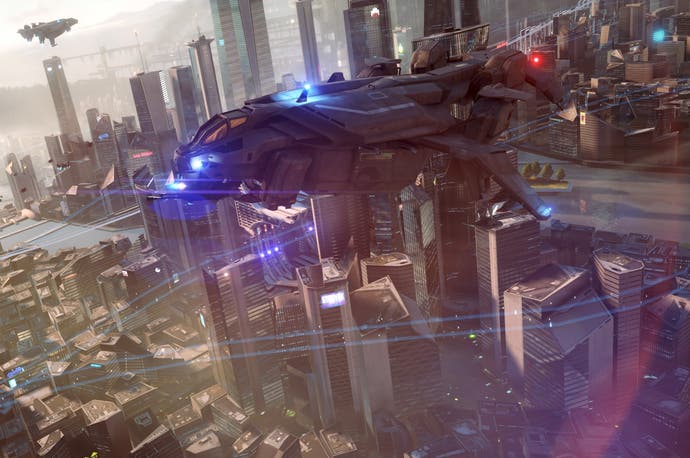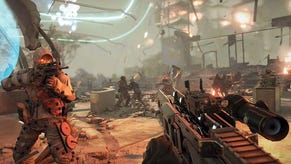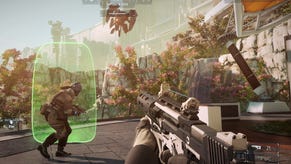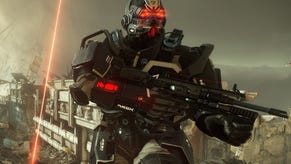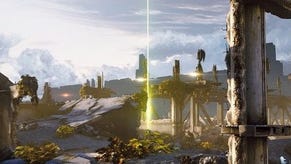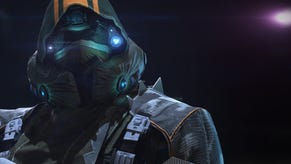Tech Analysis: Killzone: Shadow Fall demo
Digital Foundry's take on Guerrilla Games' PS4 debut.
This is it. This is PlayStation 4. With the reveal of Killzone: Shadow Fall we have our first glimpse at real-time next-generation gameplay, giving us some idea of what to expect from a technical perspective from Sony's brand new hardware. Those hoping for a leap towards 1080p resolution are likely to be pleased with the developer's efforts, while those lusting after a new 60FPS standard should prepare for disappointment. In Shadow Fall, enhanced detail, superlative effects work and solid performance are the focus over and above the 1080p60 dream, but the question is, just how much of a leap does Shadow Fall represent over what we already have? Is this truly next-generation stuff?
First impressions of the new Killzone from a technical perspective certainly don't disappoint. The tour starts with a spectacular fly around of Vekta's glimmering citadel, showing off whizzing hover-cars, tumbling waterfalls, flapping ISA banners, and more cherry blossom trees than would frankly make the cut for most other shooters. The Killzone franchise has been defined by a darker, murkier, grimier aesthetic but clearly developer Guerrilla Games intends to show off a bit more colour this time around - at least in its opening gambit - and the results are immediately eye-catching.
Last week's visually compromised live-stream and the Facebook gameplay upload don't really do justice to the scale of the visual achievement, but luckily we have access to alternative assets that completely eliminate the macroblocking blur and reveal the full extent of the new Killzone's splendour. A full HD trailer encoded in Apple's ProRes format grants us the opportunity to pore over the game's finer details at a quality level akin to the software running right in front of us. So with this resource available, it's relatively straightforward to build up a picture of Guerrilla Games' vision of what we should expect from next-gen PlayStation hardware - and 1080p is clearly the focus.
To understand this platform's future we have to address the past. Looking back at the start of this generation, the bulk of the PS3's only true, native 1920x1080 titles made an appearance during the platform's launch window. This short list included NBA '07, Tekken: Dark Resurrection and Ridge Racer 7 - all older games, where each respective engine was unshackled by the PS2's constraints on new hardware to achieve a solid 60 FPS update and attain the full HD dream. The following seven years tell a very different story, however, for both 360 and PS3 alike. With an emphasis on higher-poly environments, sharper textures, deferred lighting and advanced physics engines, we now have more technically demanding titles like Crysis 3 resorting to sub-HD frame-buffers, and often struggling to uphold their target 30FPS.
"All material we have available suggests that the new PS4 Killzone runs at a rock-solid 30 frames per second at 1080p full HD resolution."
Fast forward to the present, and we should take it as read that full HD is now the standard. Killzone: Shadow Fall is set to wave the 1080p banner when it arrives, and based on close, frame-by-frame scrutiny of the trailer, we can confirm this target is being realised fully here, giving us a crisp level of image quality we seldom see outside of PC gaming. But, while this leap gives us an impressive 2.25x pixel increase over the 1280x720 seen in Killzone 3, is this standard actually here to stay for all future releases?
The available evidence from this and other Sony trailers suggests that this is indeed the case, owing to the vastly higher fill-rates afforded by the PS4's powerful Radeon graphics processor. Chief among the priorities in its design is of 176GB/s memory bandwidth at its disposal in concert with a whopping 32 ROPs - stats that place these aspects of the PS4's architecture on a par with some of the fastest PC rendering hardware. Put into perspective, this level of throughput exceeds that of even capable £120+ PC graphics cards, including current mid-range favourite the Radeon HD 7850. Recent benchmarks of this card show little issue in running DirectX 11 titles like Battlefield 3 on high settings at 1080p60. In other words, given the right optimisation for the new version of Sony's custom LibGCM graphics library, there's more than enough of an overhead for the PS4 to push for more than what we're seeing here - or at least break even with 1080p going forward.
Even with such a high resolution in place, anti-aliasing is still necessary. The series has used a range of post-processing methods in the past, going from the blur-inducing quincunx of Killzone 2, to the sharper morphological (MLAA) method in Killzone 3. Given that we see image treatment in Killzone: Shadow Fall extends to non-geometric elements such as foliage, there's a strong indication that a post-process approach is making a return here and we wouldn't be surprised to see the return of MLAA in effect. This is backed up by the light shimmer effect we see on high-contrast edges too, showing sub-pixel noise which this method typically has trouble addressing. Even with these artifacts though, the image looks far beyond the quality console gamers have grown accustomed to. The fact is that, with more resolution to work with, the issues that have blighted post-processing AA in the current-gen era are far less of an issue at 1080p.
"Geometry detail, lighting and effects work are a leap beyond anything we've seen on the current generation consoles."

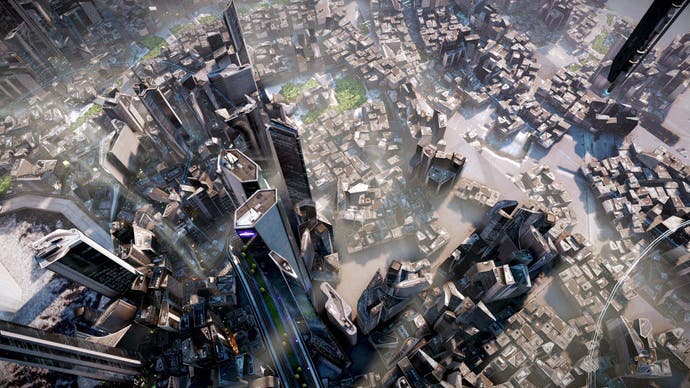
Looking past image quality, we see shader effects have been upgraded across the board from Killzone 3, encompassing heat fumes under jets, water streams from Vekta's building-sides, and the invisibility cloaking on the Helghan saboteur. Once the action kicks off proper, we spot per-object motion blur in effect too, as NPCs run individually across the war-torn streets, and across Lucas' fingertips as he reaches for the clip of his gun. Alas, the strength of the effect doesn't come out in full force on the Facebook video (as uploaded during the conference itself) due to compression, but it's very much alive and kicking and will be much more pronounced when you play the game yourself.
The sheer volume of on-screen geometry marks a bold step forward over what we've previously seen - though gameplay while on-foot is still restricted to narrow pathways. The city guards, buildings, trees and aircraft are instanced to minimise the amount of vertex data committed to the PS4's RAM; a trick we see in shooters such as Battlefield 3 too. It's well-disguised, with structures at the city basin rendered in real-time but duplicated at all manner of angles to create the illusion of a city sprawl, with the swarms of aircraft being shaded differently too. Though these are at a suitable distance to mask the trick, it's a tad glaring when ISA soldiers stand directly side-by-side in front of our lead character, with matching facial expressions used for each rig. No doubt, this is the inevitable upshot of peering into a game world via a far higher-resolution window, where all strengths and weaknesses are amplified.
Other shortcuts are surprising given the theoretical strengths of the PS4's eight-core CPU running in tandem with an 800MHz-clocked Radeon GPU. The reflection-mapping across the city's many skyscrapers may be mesmerising on first sight, but on closer analysis it's clear these surfaces aren't mirroring nearby geometry at all. Instead, Shadow Fall uses a substituted background layer of unrelated buildings to fake the effect, with no passing aircraft factoring in. As with the instancing workaround for geometry, however, the whole scene is typically moving too fast for this to become apparent; it works convincingly for the split seconds it passes your viewpoint, and then it's gone.
"Having proved its mastery of deferred lighting in its PS3 outings, Guerrilla takes it to a whole new level in Shadow Fall."
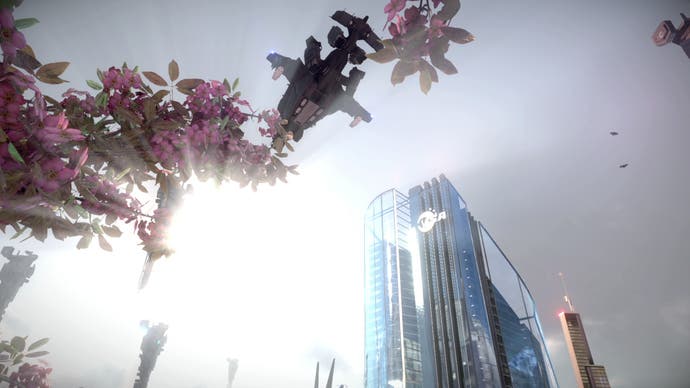
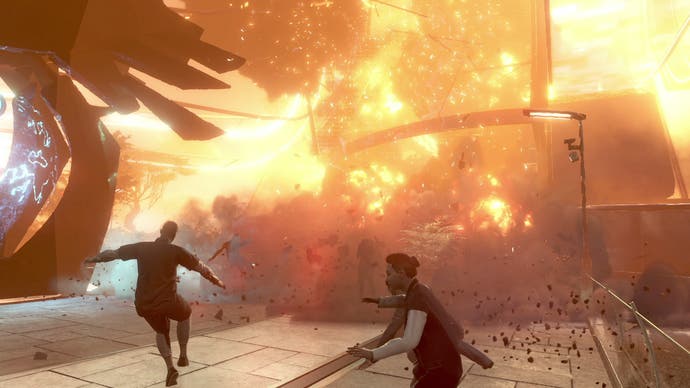
With regards texture detail, there isn't typically much striking about clean, utopian cities in video games. On the ground, we see LOD transitions for cherry blossom petals and newspapers, each gradually fading in as Lucas approaches, but the rest is as crystal clear and pristine as we'd expect. There's also no apparent pop-in for geometry, but weirdly enough for a game carrying this level of presentation, there are z-fighting issues on distant buildings, where overlapping textures of equal z-buffer values flicker into view alternately.
Thankfully, the white sheen of the city is replaced by bump-mapped cracks after the Helghan siege hits, coating the geometry with a degree of detail that matches our expectations of a next-gen FPS. Filtering cascades are detectable on the ground at this point, though, particularly on straight shadow lines, which is a little surprising given the capabilities of the hardware, and we expected the smoother anisotropic approach to make the cut. This is also odd given the range of far more demanding effects on show, such as screen-space ambient occlusion (SSAO), and the full-resolution alpha buffers used to create the billowing dust clouds beneath aircraft.
Having proven its mastery over deferred lighting in Killzone 2 and 3, Guerrilla Games is back to prove its point again in style. This time, the light-source count has bumped up considerably, with lamps lining the street floors, individually lit particles for friction sparks and flames, and global illumination - all of which bring out a vivid lens flare effect and light shafts. We see SSAO mix in with the dynamic shadows, too, the telltale sign being the dark halo artifact that forms around Lucas' gun on approaching light cover - expected, given that similar PC GPUs struggle once the horizon-based version is added. Even so, the effect adds some much-needed depth to the scene by filling in small gaps with a flourishes of shading. For a game so predicated on the dark and gritty aesthetic, it's set to be a good match as we venture further into the Helghan's smoggy, industrialised wastelands.
Havok physics on objects also make a return, with cloth simulation applied to flapping banners. As with the last release, each bullet impact clearly knocks each body part of the Helghast with according force, until we're left with ragdoll-style corpses on the ground. Alas, there isn't much in the way of destructible geometry in the vein of Battlefield 3, even in pre-determined chunks, with much of the chipping to the walls apparently pre-baked. The enemy AI flanks and adapts to the player movement in similar ways as before, but the stiff running animations from gormless-looking civilian NPCs bring us hurtling back down to reality. Even so, it's early days - and a very isolated use of these elements.
"Those expecting fluid 60FPS titles from day one will be disappointed - here the emphasis is placed on a cinematic spectacle rendered at 1080p30."
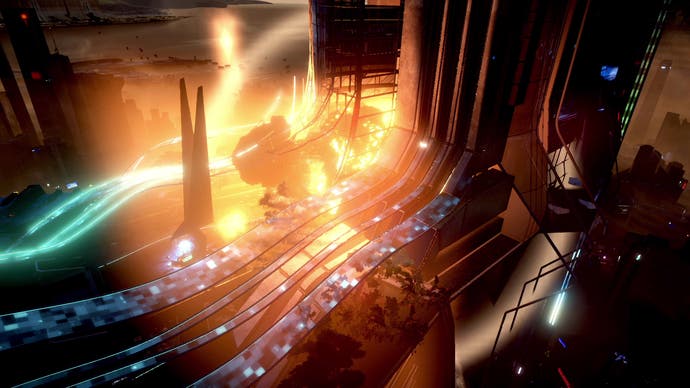

It's a beautiful game overall, but with compromises that only make sense if frame-rate has become the priority. Those hoping to see a trend of fluid 60FPS titles begin from day one will be disappointed, but for Shadow Fall the emphasis is placed on a cinematic spectacle rendered at 1080p30. The frame-rate is confirmed to be capped at 30FPS during interviews with the studio, and based on our feed we see this is absolutely 100 per cent stable throughout the entire demo. No drops, no screen tearing - it's a smooth play-through all the way, suggesting that the frame-rate could be running higher if it weren't locked down on this figure. So there's no 1080p60 here and Guerrilla's decision to lock at 30 also has implications for controller latency - it's a shame that Killzone won't have the crisp response that only 60Hz provides, and that helps makes PC gaming attractive to so many.
As it stands, the condition of Killzone: Shadow Fall's demo hints at the greater promise of its full release later this year. Regardless, and perhaps most importantly, out of all the titles showcased at Sony's event this week, Guerrilla Games is making the most practical declaration of intent for the future of PS4. Here we have unscripted stretches of gameplay on display with a multitude of effects we may well have seen in isolation on PS3, but rarely all in tandem, and never at this incredible sense of scale.
There are some curious cut-backs we didn't expect to see, but there's plenty of development time remaining until the game is finished, and with the bar being raised in almost every other category, it's perhaps inevitable that certain shortcomings - specific hangovers from the last generation - might rise to the surface. On the positive side, the push for higher-grade volumetric effects, masses of on-screen geometry, object-based motion blur, SSAO, and a full 1080p native frame-buffer all stand as the big selling points from a technical perspective in the here and now.
Based on specs alone, the PS4 clearly has far more to offer than what we're seeing, and it's worth remembering that Guerrilla would have developed a large chunk of Shadow Fall on incomplete hardware. Our understanding is that final kits based on actual PS4 production hardware are a relatively recent phenomenon, and now the developer has a fixed target to aim for, we may well see significant engine improvements. But if this stands as the level of technical quality we should expect for Shadow Fall's final release, we'll be due for one of the most technically compelling launch titles we've seen in a very long time.
